The Way It Is/The ALMS's hopes for the Delta Wingby Gordon Kirby |
 Testing of the Delta Wing continued at Sebring last week. The car will spend this week at Elan Motorsport Technology in Georgia and will soon be shipped to Europe for more testing in preparation for its competition debut at Le Mans in June. At the end of last week Ben Bowlby briefed me on the extended Sebring test session.
Testing of the Delta Wing continued at Sebring last week. The car will spend this week at Elan Motorsport Technology in Georgia and will soon be shipped to Europe for more testing in preparation for its competition debut at Le Mans in June. At the end of last week Ben Bowlby briefed me on the extended Sebring test session.
"We're getting there," Bowlby said. "On Wednesday we did our first full stint run starting with brimful tanks. We ran 150 kilometers on a tank and it was good. So we're making progress. We've been stopping and sorting problems and fixing them and going out again and finding and fixing the next problem. But through that I think we're making some improvements to the car one step at a time." Driven by Marino Franchitti, the Delta Wing shared the track with the factory Audi team, winners of the previous weekend's 12-hour race who were also busy testing for Le Mans in June. Bowlby stressed how steep the challenge is to produce a competitive and reliable car for Le Mans in such a short time frame. 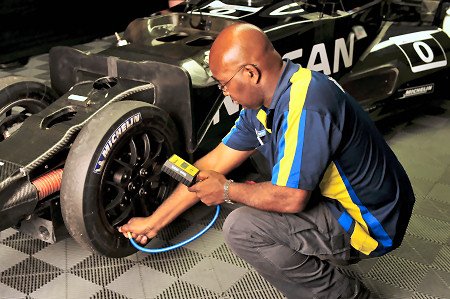 © Nissan DeltaWing Meanwhile, I talked last week with Don Panoz and Scott Atherton about their hopes and plans for the Delta Wing. Panoz hopes to begin building cars at Elan Motorsports Technology in Braselton, Georgia once the concept has been proven at Le Mans while ALMS boss Atherton hopes the prototype will run in some ALMS races later this year with Panoz production cars racing regularly in the ALMS in the coming years. "This is a long journey," Panoz remarked. "The car is running and Gurney's group put out every kind of effort to get the car ready and running. Now, we've got the equally huge effort of testing the car and preparing to run Le Mans in less than three months." Panoz paid tribute to Bowlby and his design team led by Zach Eakin and Simon Marshall for their commitment to the project, and to Dan Gurney and All American Racers for their work in building the prototype. "Ben had a dream and once some of us who knew him pretty well got to see it and understand it came faith and believing," Panoz said. "Ben and his team, Zach and Simon, and Gurney and his team have done a tremendous job. They had a plan and a concept and they asked themselves all kinds of technical questions and were convinced it could work." Panoz enthusiastically described the near-miracle in pulling together the Delta Wing's key elements--car, engine, tires, transmission, etc--in a remarkably short time from disparate corners of the world. "At that juncture the car was being drawn and molds and tools were being made," Panoz related. "You had Dan Gurney's group and all his people in California who have been with him for many years. They were dedicated to the project, making jigs and tooling and pieces based on theory. "Then you had Michelin who have been a great contributor to this project. They committed their resources and engineers without an actual car just on the basis of the design and theory. On that basis they designed a tire for a car they couldn't see and had yet to be proved, which is basically unheard of. 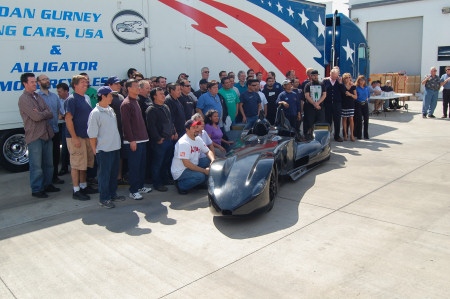 © John Zimmermann "And at the last minute, three weeks before March 1st, all that came together and created a car which no one had ever seen before. It was like you brought in a group of trumpet players from one orchestra, some violin players from another orchestra and a drummer and piano player from somewhere else and you had some music that was a new composition and they opened the curtains and they all sat down, picked up their instruments and played it perfectly. How can you imagine it could happen? But it did." Panoz applauded Chip Ganassi, AAR, Michelin, Nissan and Duncan Dayton for their efforts in making the Delta Wing dream a reality. "I've got to thank Chip Ganassi because he was responsible for the first concept," Panoz said. "There's a lot of intellectual property on this car. It's about six or seven inches thick. Chip supported all that and he's given us a license. He's not taking a royalty. He'll share in the results of the business with all the other partners. He's a great credit to this. I can imagine that he's been politically challenged in racing in some instances because of this, but he supported it and stuck with it. "For the Gurneys to take this project on in California was just fantastic. They hadn't built a car in ten years and what an effort they put in! Dan's got a fantastic staff of tremendously experienced people and they did a magnificent job. "For Michelin to commit all the engineering to build tires that are completely outside the box and for Nissan to build the first of these new Global Racing Engines, that takes courage. The people who took those decisions know that if it doesn't work their jobs and careers are on the line. So they are very courageous people and they deserve a lot of credit. "And of course, Duncan Dayton was a key man in getting people excited about and sold on the Delta Wing concept. It was like we had different skill sets that came together to produce the car." Panoz says most of the jigs and tooling, excluding some parts that AAR will continue to manufacture, have been shipped to Elan Motorsports Technology in Georgia. Following last week's Sebring tests the Delta Wing was trucked to Georgia prior to being flown to Europe for more testing. "Ben, Zach Eakin and Simon Marshall will work with the Elan Motorsports Technology people," Panoz said. "They'll learn to understand the components and the parts. Then the car will go to Europe the following week and go to Spain for testing and then do some more testing at Magny Cours." 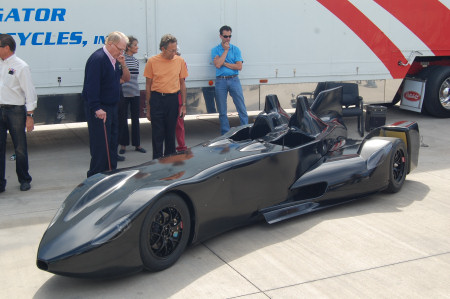 © John Zimmermann "Our race at Le Mans is one that we can't win and it's one that we can't lose," he said. "The point is not to go to Le Mans to be a tough competitor to win the race. The car was selected and invited to race because they want to see better efficiency and improved fuel consumption and our race at Le Mans will be to prove all those things--to achieve equal performance with better fuel consumption and overall efficiency. "We are going there to race our technology and to race against our technology. We're not out to get in anybody's way at the track. We're an invitee and we want to prove the fuel consumption, the power and that the car can perform on speed. We want to prove the tires and all the other elements of the car in the conditions of a 24 hour race. "We're invited to Le Mans to prove that with new technology you can go as fast and be competitive with half the amount of fuel or half of the tire changes. Then after we've done that we have to decide whether that's interesting new technology and good-bye, or we're going to find a way to integrate it into racing. That's the dream and the objective that we're working on." The specifics of how to integrate the Delta Wing into the ALMS will be grappled with after the car races at Le Mans. "When we've completed the first task at Le Mans in June we'll have a standard or an outline of what this car really is and how we look at it in terms of the rules and what has to be developed," Panoz observed. "Is it to run as a separate class or will we integrate it into the existing LMP categories? It has to be a fair competitor to cars that are already racing and their teams. We can't step off the block at Le Mans and say everybody's got to change and go our way. We've got to be rational and make sure there's an orderly transition. "We have a business plan," he went on. "Our business plan for the Delta Wing starts with gaining all the knowledge we need to acquire from testing and racing the car. Our plan is that we will make cars. We think this basic chassis could be good for LMP1, LMP2 or LMPC, but again, that's something that has to be confirmed at the track by performance. We will start to work in that direction and we'll work closely with IMSA, the ALMS, the ACO and the FIA. "A new bridge isn't easily crossed the first time and we've got to find a way to get over that bridge but not to scare anybody. I don't know if this car is capable of doing that, but it's going to prove itself. We've got to find a way to incorporate ourselves with racing and with the sanctioning bodies and the teams. We've got to be a welcome addition, not something that, politically, people want to get rid of." Scott Atherton echoed Panoz's hopes of introducing the Delta Wing to the ALMS as soon as possible. 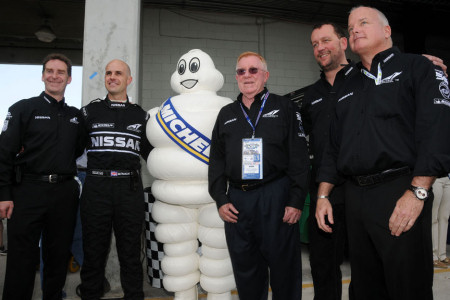 © Paul Webb "If that occurs we would then love to have the car committed as fast as possible to the American Le Mans Series. We would welcome it with open arms. This car is completely aligned with what the ALMS has always stood for and has become more crystallized in recent times as being the ultimate platform for manufacturers to bring new technology like the Delta Wing and demonstrate it. It's the poster child for 'green' racing. "Initially, our intention would be to allow the car to compete unclassified so as to not upset the current status quo. But in the not distant future the ultimate conclusion would be for the car to be incorporated as a fully homologated competitor in our LMP category. This car is not far from complying with the LMP regulations as it is and right now it's undetermined whether the car would run as an LMP1 or LMP2. Depending on how the car's drivetrain is configured it will be determined if it runs in LMP1 or LMP2." Of course, LMP2 focuses on production-based engines while LMP1 permits all manner of pure racing engines. The Delta Wing is designed specifically for Nissan's 300 bhp 1.6 liter turbo four-cylinder 'Global Racing Engine'--a production-based, non-stressed engine--but can be powered by a variety of powerplants, hybrids or electric included. "Don's view would be to have at least two versions of the car available to compete," Atherton added. "And we would welcome that just as we have Lola, Zytek, Morgan and other competitors that are building prototype chassis." After Le Mans Atherton wants to see the Delta Wing compete in at least some of this summer's ALMS races. "At a minimum for 2012 we expect the car to be at Petit Le Mans," he commented. "I think there will be selected other ALMS races that the Delta Wing group and we here at the ALMS will want it to compete at, but those plans are yet to be confirmed. "Our goal again from a series perspective is as soon as possible to be able to publish when the Delta Wing will be competing in the ALMS. I know the Delta Wing group have some plans to race the car in some high profile events and opportunities around the world to further solidify the significance of what this car represents. From our own selfish perspective I want to nail down as many ALMS dates as we possible can, more than just Petit Le Mans at the end of the season. "We're looking at what the market will dictate. The market is never wrong in terms of determining the desirability of having this car." Atherton believes Peugeot's withdrawal from the World Endurance Championship and Le Mans will result in more media attention for the Delta Wing.  © Paul Webb "So the assumption is that Le Mans will be an Audi freight train and the real story will be, 'How is the Delta Wing performing?' The car has already had a global uptake but once it runs at Le Mans that will be put on steroids. For us selfishly to parlay off its impact at Le Mans and have all that energy and excitement be part of the ALMS going forward will make us a winner." Atherton said a huge amount of time and effort went into recreating the Delta Wing as a Le Mans-type sports car after the concept was rejected by IndyCar in June of 2010. "It's an interesting story how this whole process came to be from an Indy car concept and a program that had literally been put to death," Atherton remarked. "It had no pulse but a phone call from Al Speyer asking if you guys would at least take a meeting to understand the technology behind this and hopefully see a way forward got the ball rolling in a new direction. "It took a lot of work selling the concept to the ACO as being appropriate for their 56th garage and then putting the group together that put the resources in place to get it built and up and running. It's a hell of a story. A lesser concept would have faded into the history of great ideas that never quite made it. "Ben staked his reputation and career on it," Atherton added. "Hats off to him and everyone who defied gravity to help make it happen." Atherton chuckled about many Delta Wing critics who have become supporters since the car has begun to show what it can do. "It's been humorous to watch and listen to some of the commentary," he grinned, "because there were so many nay-sayers and now everybody is chiming in." Atherton also praised Chip Ganassi for his essential role in launching the Delta Wing concept. 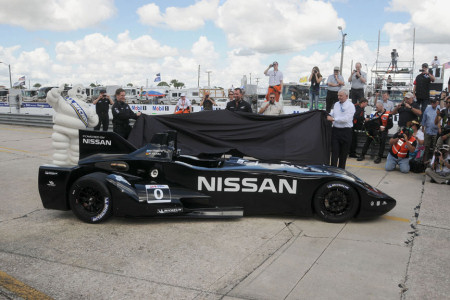 © Paul Webb Atherton also emphasized that the Delta Wing is a perfect fit with the ALMS's open rulebook and green racing initiative. "All of the manufacturers are saying unprecedented innovation will have to occur between now and 2025 in order to meet the new CAFE standards," he observed. "And I submit that the Delta Wing is example number one of how we will get there. I think it just adds fuel to the fire of how racing is improving the breed in the modern era versus its original role back at the beginning which was to demonstrate the fundamentals of reliability and the earliest measures of performance. In 2012 we're focused on entirely different things but the purpose of motorsport is unchanged and that's where I believe our series and our platform separates from all others. "We have a platform here at the ALMS that is working and I couldn't be happier. It encourages and incubates this type of technology whether it's Porsche's flywheel hybrid or Audi's turbo diesel. Truly the definition, the benchmark is embodied in the Delta Wing." Don Panoz added that the lessons of the Delta Wing will enjoy wide application. "It goes beyond racing," Panoz commented. "There's a lot of stuff with this car that can be applied to road cars. There's improved efficiency, aerodynamics and construction techniques. There are lot of things this car can showcase and be used across the automotive industry. "I think the benefits of this car--the same speed for half the rubber, half the fuel and weight--the amount of resources you will cut down to use this car will be much reduced. Just think of the tires, for example. It'll use half the number of tires and half the number of trees cut down and half the fuel to get that rubber to the track. It will have a dramatic impact on conservation and we need to do that. The Delta Wing is the epitome of that. I think it's just a fabulous project." I agree wholeheartedly. The Delta Wing surely will prove to be motor racing's story of the year, if not the decade, and I'll continue to closely follow its unfolding path in the coming weeks. |
Auto Racing ~ Gordon Kirby Copyright 2012 ~ All Rights Reserved |
